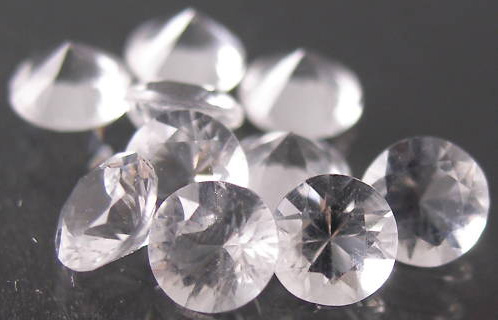Pollucite

Pollucite
(From Pakistan. Weight: 1.50 carats total)
Image © supplied by Woodmansee* Gems
Pollucite History & Etymology:
Pollucite was discovered by August Breithaupt in 1846, on the island of Elba, Italy. The gemstones of Pollucite are recognized by the IMA and Pollucite is considered to be a grandfathered mineral.
Pollucite derives its name from the twin brother of Castor; Pollux. Pollux and Castor are considered to be heavenly twins and also the brothers of Helen of Troy according to Greek mythology.
Pollucite Occurrence:
Gemstones of Pollucite are extremely rare and extremely small as they contain the rare earth element cesium. The Pollucite mineral itself is quite rare and yields very minuscule quantities of gem Pollucite. Pollucite is found on the island of Elba and in the Livorno Province in Tuscany, Italy.
Crystals of Pollucite have also been found in Nilaw in the Nuristan district in the Laghman Province in Afghanistan, in Mogok in Myanmar, in the districts of Skardu, Gilgit and Shengus in Pakistan and in Transbaikalia in the Eastern Siberian region of Russia.
The largest crystals of Pollucite have been found in the area where they were first discovered, on the island of Elba. These crystals of Pollucite are transparent and are prized possessions in a gemstone collector’s collection because of their rarity.
Pollucite Properties:
Pollucite is composed of hydrated cesium sodium aluminum silicate. The dominant silicon in the composition of Pollucite classifies the Pollucite mineral as a silicate mineral. Pollucite belongs to the Zeolite group and to the Analcime-Paulingite Series.
Pollucite displays isometric as well as hexoctahedral properties and the Pollucite crystals are usually found as striated cubes. Pollucite is extremely rare but when found are seen to have dodecahedra as well as trapezohedra symmetries. The crystalline masses of Pollucite are usullay at least 12 cm in size. The crystalline masses have a granular texture and twinning in the Pollucite crystals is not observed.
Pollucite also does not display any cleavages rather show conchoidal to uneven fracturing. The uneven fracturing in Pollucite makes the Pollucite crystals extremely brittle. However the Moh’s hardness of the Pollucite crystals is between 6.5 and 7. Pollucite is not very dense and have an approximate density of 3 g/cm3.
Pollucite displays a fluorescent luminescent property. The Pollucite crystals appear creamy white or bluish green under UV light of short wavelength and appear a weak orangish color under UV light of short wavelength. Radioactivity in Pollucite is barely detectable. The radioactivity of the Pollucite crystals has been found to be at GRapi=484.85.
Pollucite is usually colorless but also occur in the colors of white and gray. Pale pink, blue and violet colored crystals of Pollucite also occur but are extremely rare. Pollucite is extremely sought after by gemstone collectors due to its rarity.
Back to the Gemstones List home page - over 160 gemstones explored!
Please feel free to link to this page - copy / paste the text below: (click to select)
Privacy Policy | Cookie Policy | GDPR | About This Site / Terms

© gemstoneslist.com 2018


